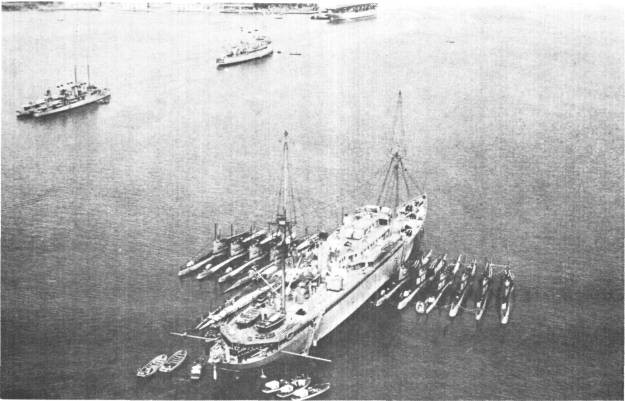Holland II (AS-3)

(AS-3: dp. 8,100; l. 483'10" ; b. 61'1" ; dr. 16'9" ; s. 16 k ; cpl. 388; a. 8 5", 4 3")
John Philip Holland, the man who developed the first true submarine accepted by U.S. Navy (spending 57 of his 74 years working with submersibles), was born in Liscannor, County Clare, Ireland, on 29 February 1840. As a youth, he considered the use of the submarine to further the cause of Irish Independence. Holland came to the United States in 1873. In 1875 his first submarine designs were submitted for consideration by the U.S. Navy, but turned down as unworkable.
Holland continued to improve his designs and worked on several experimental boats prior to his successful efforts with the privately built Holland launched in 1898. This was the first submarine having power to run submerged for any considerable distance. She was purchased by the Navy after rigorous tests, and six more of her type were ordered.
On 12 August 1914, John Philip Holland died in Newark, N.J.
II
The second Holland was launched by the Puget Sound Naval Shipyard, Bremerton, Wash., 12 April 1926, sponsored by Miss Elizabeth Saunders Chase, daughter of Admiral J. V. Chase, and commissioned 1 June, Comdr. John B. Earle in command.
Holland arrived in San Francisco from Puget Sound Naval Shipyard on 24 April to become flagship of Captain J. T. Thompkins, Commander Submarine Divisions, Battle Fleet. On 24 September she was permanently assigned to base at San Diego, Calif., tending submarine divisions there with periodic tours to Panama to service submarines based at the Canal Zone. On 5 November 1930 Holland became flagship of Captain Chester W. Nimitz, Commander Submarine Divisions, Battle Fleet with additional duty as Commander of Submarine Division 20. The former command was abolished as of 1 April 1931 and Captain Nimitz retained his flag in Holland as Commander, of his submarine diyision, now designated Submarine Division 12. He left Holland on 17 June, relieved by Captain W. L. Friedell.
In addition to being the flagship of Submarine Division 12, Holland temporarily served as Submarine Force Flagship (March-July 1933). In June 1935 she became joint flagship of Submarine Squadron 6 and Submarine Division 12. This duty continued until June 1941 when she became flagship of Submarine Squadron 2.
On 22 November 1941 Holland arrived at Cavite Naval Base, P.I., to service submarines of the Asiatic Fleet. Due 'to the air raids in early December 1941, Holland was hurried out of Manila Bay under cover of night with her vital cargo of repair and replacement parts for submarines of the Asiatic Fleet. Heading south, she escaped unscathed from two air raids while at Balikpapan, Borneo, then repaired a battle-damaged submarine at Soerabaja, Java where she was joined by two destroyers that gave her escort to Port Darwin, Australia, which she reached on 2 January 1942 for round-the-clock operations which included the building of docks and floats as well as the constant repair and equipping of ships as well as submarines. On 3 February she was underway for Tjilaljap, Java, to remove Rear Admiral Charles A. Lockwood, Jr., and his Asiatic Fleet Submarine Force Staff to Australia. Her outstanding service to the Fleet during the first crucial months of the war brought Holland a Navy Unit Commendation.
While based in Australia, Holland serviced and overhauled several submarines before returning for overhaul at Mare Island Navy Yard in late February 1943. She reached Pearl Harbor from the West Coast in June and completed 22 refits and 13 repair jobs for submarines within the next 11 months. She shifted to Midway Atoll on 1 June 1944 and sailed the following month directly to support submarines in the Marianas Islands. Holland returned to Pearl Harbor late in November to be fitted out as headquarters ship for Vice Admiral Charles A. Lockwood, Jr., Commander Submarine Force, Pacific Fleet. In January 1945 she steamed out of Pearl Harbor for Guam where she embarked Vice Admiral Lockwood. By the close of hostilities, Holland had given 55 instances of refit to submarines, provided repair and service to 20 surface craft and completed various jobs on shore installations.
Vice Admiral Lockwood shifted his Submarine Force Flag ashore to his new quarters on Coconut Island in Apra Harbor on 30 August 1945, setting up operations and communications for the work ahead. This left Holland ready to begin a new career as a repair ship (ARG-18). Her value to the submarine force had diminished with the commissioning of many new and modern tenders better equipped to carry on the job of keeping our submarines in condition for their assaults against the enemy. With a few alterations she headed for Buckner Bay, Okinawa, where she embarked Rear Admiral Allen B. Smith, Commander of Service Squadron 10 and his staff before proceeding for Tokyo Bay where she dropped anchor on 29 September 1945.
Holland set course 6 June 1946 by way of Pearl Harbor for San Diego where she arrived on 28 June. She shifted to San Pedro for inactiviation overhaul in the Terminal Island Navy Yard, then was towed to San Diego where she was decommissioned on 21 March 1947. She was assigned to the San Diego, Calif., group of the Pacific Reserve Fleet until her name was struck from the Navy Register on 18 June 1952. Her hull was sold for scrapping on 3 October 1953 to the Bethlehem Steel Co.
Holland earned two battle stars and the Navy Unit Commendation for World War II service.


